15 years one-stop China custom CNC machining parts factory
 233 |
Published by VMT at Feb 22 2025 | Reading Time:About 6 minutes
233 |
Published by VMT at Feb 22 2025 | Reading Time:About 6 minutes
Problem: Are you looking for a versatile, cost-effective manufacturing process for creating high-strength parts? Whether you're working on automotive components, aerospace parts, or intricate sculptures, the process of metal casting is likely an essential solution.
Agitation: However, navigating the world of metal casting can be confusing. With so many processes, materials, and requirements to consider, how do you determine which approach will provide the most efficient and reliable results for your specific project?
Solution: In this article, we will break down the core aspects of metal casting, explaining the different types, processes, materials, and advantages. We will also explore how metal casting integrates with modern CNC machining and how this combination enhances precision and quality for custom CNC machining parts.
Metal casting is a manufacturing process where molten metal is poured into a mold to create parts or products. It offers unmatched versatility and can accommodate a wide range of materials, from steel to magnesium. The process can be adapted for both high-precision CNC machining services and larger industrial components. Whether it's for automotive parts or intricate jewelry, metal casting is a cost-effective and reliable solution.
Now that you have a basic understanding of what metal casting is, let’s dive into the specific processes involved in making metal castings and how they contribute to the production of CNC machining parts.
Metal casting is the process of shaping molten metal into specific forms by pouring it into a mold. The metal is heated to its liquid form, poured into a mold, and allowed to cool and solidify. This process results in the creation of a casting, which can be further refined and processed to meet precise specifications. Metal casting is a vital component in producing parts for industries such as automotive, aerospace, and construction, among others.
In many cases, metal casting is combined with CNC machining services to further refine the cast parts. CNC machining allows for high-precision work on complex geometries, improving the accuracy and surface finish of metal castings. This collaboration between casting and CNC machining ensures that custom CNC machining parts meet exact requirements and tolerances.
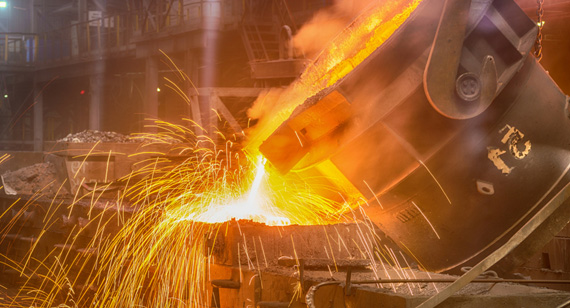
The metal casting process involves several key steps: making the pattern, creating the mold, melting and pouring the metal, and finishing the casting. First, a pattern is created, typically using a material like wax or sand, which resembles the final shape of the casting. The pattern is then placed in a mold, made from materials like sand, ceramic, or metal.
Next, the mold is heated to a high temperature, and molten metal is poured into it. The metal fills the mold and solidifies as it cools, taking the shape of the mold. After cooling, the casting is removed from the mold, and any finishing processes, such as grinding or polishing, are performed.
In CNC machining factory operations, the final castings are often subject to CNC prototype machining to ensure the part meets design specifications. This collaboration ensures the parts' performance and precision in their final application.
Several metal casting methods exist, each with its own advantages. These methods are chosen based on the type of material, the complexity of the part, and the desired finish. Some common processes include sand casting, die casting, and investment casting. Each process requires careful attention to detail to ensure that the metal flows properly into the mold and solidifies without defects.
Making the Pattern
The first step in metal casting is creating a pattern that will serve as the model for the final product. This pattern can be made from various materials, including wax, sand, or metal, depending on the casting method. In CNC machining parts, the pattern must be highly accurate to ensure the final product aligns with design specifications.
Making the Core
In some casting processes, a core is used to create internal features or hollow spaces in the casting. The core is typically made from a material such as sand or metal and is placed inside the mold. The core remains in place while the molten metal is poured around it, forming the desired internal features of the part.
Making the Mold
The mold is created to hold the molten metal and shape it into the final casting. In sand casting, the mold is made by packing sand around a pattern. In other processes like investment casting, molds are typically made from ceramic or metal. The mold must be sturdy enough to withstand the heat of the molten metal and provide the necessary detail for the final part.
Melting and Pouring the Metal
Once the mold is prepared, the metal is heated to its molten state in a furnace. This step requires precise temperature control to ensure the metal flows smoothly into the mold. After the metal reaches the appropriate temperature, it is poured into the mold, filling it completely.
In custom CNC machining, the quality of the molten metal is crucial, as defects in the material can result in poor casting performance. Therefore, it is essential to select the right metal and control the pouring conditions to avoid inclusions or oxidation.
Removing the Metal Casting from the Mold
Once the metal has cooled and solidified, the casting is removed from the mold. The mold material is typically broken away, and the casting is cleaned to remove any residual mold material. This step is important to ensure the casting maintains its shape and integrity.
Finishing and Post-Processing
After the casting has been removed from the mold, it undergoes various finishing operations. These can include grinding, polishing, and machining to improve the surface finish and ensure that the part meets design tolerances. In CNC prototype machining, these post-processing steps are crucial for creating high-precision custom CNC machining parts used in industries such as aerospace or automotive.
One of the primary advantages of metal casting is its versatility. It can accommodate a wide range of metal types, including steel, aluminum, and magnesium. This allows manufacturers to choose the best material for each application, whether it’s for high-strength components or lightweight parts.
Casting is also highly cost-effective, especially for mass production. Once the mold is created, casting can be repeated many times, making it an efficient process for producing large quantities of identical parts. Additionally, the ability to cast complex shapes reduces the need for additional machining, saving both time and money.
Metal casting has been practiced for thousands of years, dating back to ancient civilizations such as Egypt, China, and Mesopotamia. Early methods of casting were relatively simple, using sand molds and primitive tools to create objects like jewelry and tools. Over time, metal casting evolved, with advancements such as the introduction of metal molds and the development of more sophisticated techniques like die casting and investment casting.
Today, metal casting is a highly refined process used across a variety of industries, from automotive manufacturing to the production of art and sculpture. Modern casting methods combine traditional techniques with advanced technologies, such as CNC machining, to produce high-precision parts for demanding applications.
Metal casting is a versatile manufacturing process that allows for the creation of complex shapes by pouring molten metal into molds. The process can be customized to meet specific requirements in terms of material, part geometry, and production volume. There are various casting methods, each with its unique advantages and applications. In this section, we will explore some of the most commonly used metal casting types, including sand casting, which is one of the oldest and most widely employed methods in modern manufacturing.
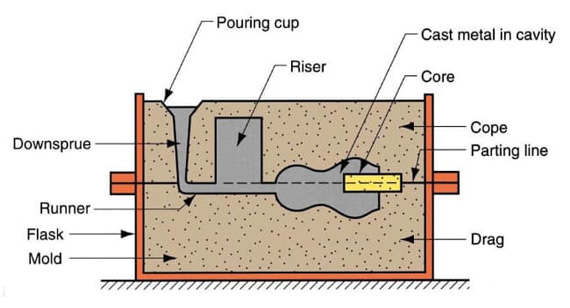
What is Sand Casting?
Sand casting, also known as sand mold casting, is one of the most common and oldest forms of metal casting. It involves creating a mold from a mixture of sand, clay, and water, into which molten metal is poured to create a desired shape. The sand mold is typically formed by compacting sand around a pattern that represents the final casting. After the molten metal is poured into the mold, it solidifies, taking on the shape of the cavity created by the pattern. Once the metal has cooled, the mold is broken apart, and the casting is removed.
One of the key advantages of sand casting is its ability to produce large, complex shapes, making it ideal for industries like automotive, aerospace, and construction. Additionally, sand casting is relatively low-cost and can be used with a wide range of metals, including aluminum, cast iron, and steel. It is also versatile in terms of scale, from small prototype parts to mass-produced components.
Three Most Common Sand Casting Processes
1. Wet Sand Casting
Wet sand casting is one of the most traditional sand casting methods. It involves mixing sand with water and a binding agent, usually clay, to create a mold. The mixture is then compacted around a pattern to form a mold cavity. The mold is then baked or dried before the molten metal is poured into it.
One of the main benefits of wet sand casting is the fine surface finish it can produce, as the wet sand helps to create smooth contours and fine details. This process is commonly used for small to medium-sized parts where precision and surface quality are important. Additionally, wet sand casting allows for the use of various metal types, making it highly adaptable for different applications.
2. Air Casting
Air casting, also known as air-set sand casting, is similar to wet sand casting, but with a key difference: the sand mixture is not mixed with water. Instead, it is combined with a binder that hardens when exposed to air, allowing the mold to solidify without the need for drying. The binder is typically a chemical resin that reacts with the air, forming a rigid structure.
This method is often used for producing complex shapes and parts with intricate geometries, as it allows for more detailed and refined molds than traditional wet sand casting. Air casting is particularly useful for creating thin-walled or high-precision components, making it ideal for industries like aerospace and automotive where dimensional accuracy is crucial.
3. Resin Sand Molding
Resin sand molding is a modern variation of sand casting that uses a synthetic resin binder mixed with sand to create the mold. The resin is typically activated by a chemical reaction, which causes the sand particles to bond together and form a rigid mold. This method offers many advantages over traditional sand casting, including faster production times, better surface finishes, and higher dimensional accuracy.
Resin sand molding is often used for producing highly intricate and detailed parts with tighter tolerances. The combination of the resin binder and sand mixture allows for molds to be created more quickly and with better repeatability. This process is widely used in industries that require both high precision and high volume, such as the manufacturing of engine components, industrial machinery, and even complex art pieces.
In summary, sand casting is an essential part of the metal casting process, and there are several different methods to choose from depending on the complexity of the part and the material being used. Whether you're using traditional wet sand casting, air casting for precision parts, or resin sand molding for quicker and more detailed molds, each method provides distinct advantages that contribute to efficient and cost-effective production.
By understanding the differences between these sand casting processes, you can select the most appropriate one for your manufacturing needs, whether for CNC machining services, custom CNC machining parts, or mass production of high-quality cast components.
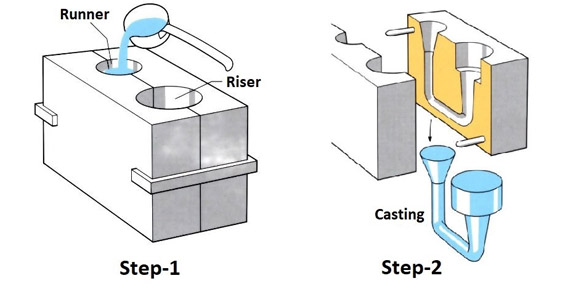
What is Die Casting?
Die casting is a metal casting process that involves forcing molten metal into a mold cavity under high pressure. The mold, known as the die, is made from a durable material such as steel, which is capable of withstanding the pressure and heat generated during the process. Once the molten metal enters the die, it is rapidly cooled and solidified into the desired shape. Die casting is used for manufacturing high-volume, precision parts with complex shapes and tight tolerances, making it an ideal method for industries such as automotive, aerospace, and electronics.
There are two main types of die casting processes: hot chamber die casting and cold chamber die casting. Hot chamber die casting involves a machine where the molten metal is stored in a furnace and injected directly into the die, while cold chamber die casting requires the molten metal to be manually ladled into the injection system. The choice between these two methods depends on the specific type of metal being used and the volume of parts being produced.
One of the significant benefits of die casting is its ability to produce parts with excellent surface finishes and high dimensional accuracy. The process is particularly effective for metals like zinc, aluminum, and magnesium. Die casting is known for its speed and cost-efficiency in producing large quantities of parts, making it a preferred method for mass production.
Investment Casting (Lost Wax Casting)
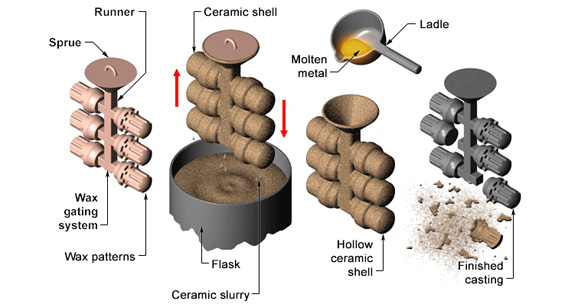
Investment casting, also known as lost wax casting, is a precise metal casting process used to produce complex shapes with fine details. The process begins by creating a model of the part using a material like wax, which is then coated with a ceramic shell. After the shell hardens, the wax is melted and drained away, leaving a cavity in the shape of the part. This cavity is then filled with molten metal, which solidifies to form the final product.
Investment casting is highly suitable for producing intricate and detailed components, including those with thin walls or complex geometries. It is commonly used in industries like aerospace, medical devices, and jewelry, where precision and surface finish are critical. The process can be used with a wide variety of metals, including stainless steel, titanium, and gold. While investment casting is more labor-intensive and expensive than other casting methods, it offers superior quality, making it ideal for producing high-end or specialty products.
Gravity Casting
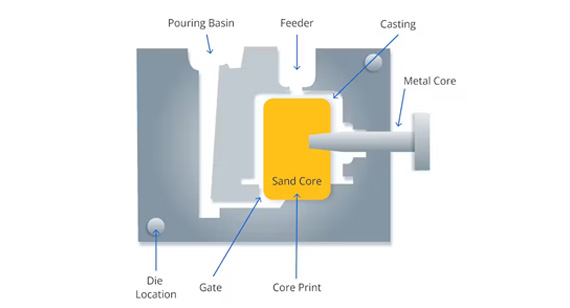
Gravity casting is one of the simplest and most common types of metal casting. It involves pouring molten metal into a mold under the force of gravity, allowing the metal to fill the mold cavity and solidify into the desired shape. Unlike die casting, where pressure is applied, gravity casting relies purely on the force of gravity to move the metal.
This casting method is typically used for larger, less complex parts and is ideal for materials such as aluminum, cast iron, and bronze. Gravity casting is known for being more cost-effective than high-pressure methods like die casting. It also allows for larger castings, making it useful in industries such as automotive, construction, and industrial machinery. However, gravity casting may not be suitable for high-precision or intricate designs due to the lack of external pressure.
Centrifugal Casting
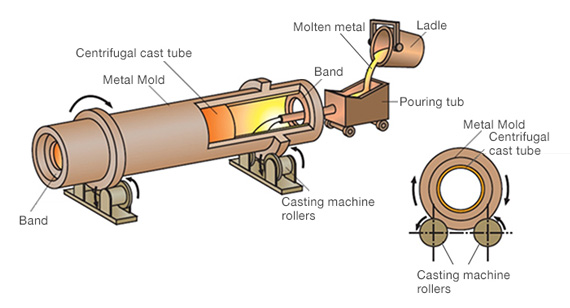
Centrifugal casting is a casting method in which molten metal is poured into a rotating mold. The centrifugal force created by the rotation helps distribute the metal evenly along the mold’s walls, resulting in a denser, more uniform casting. This technique is primarily used for creating cylindrical or hollow parts, such as pipes, rings, and sleeves.
Centrifugal casting offers several advantages, including high material integrity and the ability to produce parts with a dense, homogenous structure. It is commonly used for producing components like pipes for the oil and gas industry, as well as rings and other critical parts for machinery. Additionally, centrifugal casting can be used with various metals, including copper, steel, and aluminum alloys, and is known for producing high-strength, durable parts with excellent dimensional accuracy.
Continuous Casting
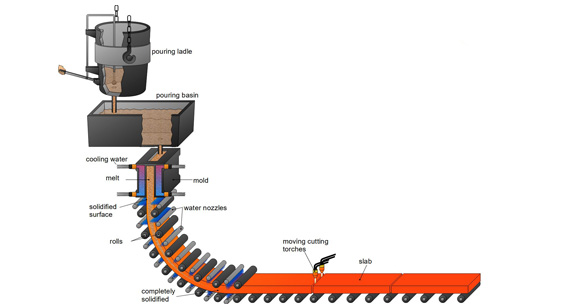
Continuous casting is a method used to produce metal shapes, such as slabs, billets, and blooms, in a continuous process. The molten metal is poured into a mold, where it begins to solidify. The semi-solidified metal is then continuously pulled through the mold, allowing the material to retain a consistent shape throughout its length. This process is ideal for producing long, uniform sections of metal, which can later be further processed into finished products.
Continuous casting is widely used in the production of steel and aluminum products, particularly in industries like construction, automotive, and aerospace. This method offers several benefits, including high production efficiency, minimal material waste, and excellent material properties. It also allows for large-scale production of long metal sections, making it an ideal solution for high-volume applications.
Other Casting Processes
In addition to the commonly used casting methods outlined above, there are several other specialized casting processes designed to meet the unique requirements of different industries. Some of these processes include:
Each of these processes offers specific advantages depending on the application, such as improved material properties, precision, or the ability to create complex geometries.
In conclusion, there are various types of metal casting, each with unique benefits suited to specific needs and applications. Whether it's the high-precision nature of investment casting, the cost-efficiency of gravity casting, or the continuous production benefits of continuous casting, choosing the right process for your project can ensure the production of high-quality parts. As industries increasingly demand customized, high-performance components, selecting the appropriate casting method—along with CNC machining services—becomes crucial to meet both production and quality requirements.
Casting pressure plays a crucial role in determining the quality, precision, and efficiency of the casting process. The two primary types of casting pressure are high pressure and low pressure, each with its own distinct set of advantages, applications, and limitations. Understanding the difference between these two methods can help manufacturers choose the most appropriate approach for their production needs.
When deciding on the pressure to be applied during the casting process, several factors come into play, including the type of metal being cast, the complexity of the part, and the intended use of the final product. The pressure chosen impacts not only the casting quality but also the production speed and overall cost-effectiveness. Below, we explore high-pressure and low-pressure casting in more detail.
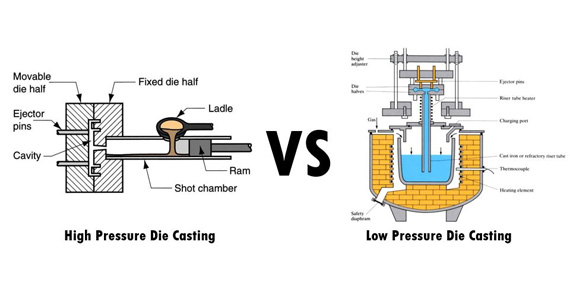
High Pressure Casting
What is High Pressure Casting?
High-pressure casting, also known as die casting, involves injecting molten metal into a mold under extremely high pressure—usually between 1,000 to 30,000 psi. This process allows the metal to flow quickly and completely fill intricate mold cavities, capturing fine details and complex shapes. The pressure is typically applied using a specialized machine, which forces the molten metal into the die through an injection system. Once the metal has solidified, the die is opened, and the cast part is removed.
High-pressure casting is commonly used with non-ferrous metals like aluminum, zinc, and magnesium alloys. This method is particularly beneficial for producing high-volume parts with excellent surface finish and tight tolerances, such as automotive and electronics components. The rapid solidification process in high-pressure casting leads to smooth surfaces and enhanced mechanical properties, making it ideal for parts that require high strength and durability.
Advantages of High Pressure Die Casting
However, high-pressure casting does require significant upfront investment in dies and equipment, making it more cost-effective for high-volume production runs rather than small batches or prototypes.
What is Low Pressure Die Casting?
Low-pressure die casting is a casting process where molten metal is injected into a mold cavity under low pressure, typically ranging from 0.5 to 2 bars. Unlike high-pressure casting, the metal is pushed into the mold by the force of pressurized gas rather than a mechanical injection system. This results in a slower, more controlled filling of the mold, reducing the risk of defects such as turbulence or trapped air.
Low-pressure die casting is typically used for casting larger, more complex parts that require a high degree of structural integrity. The process is ideal for metals such as aluminum, magnesium, and copper alloys. It is often employed in industries like automotive and aerospace, where strength, precision, and quality are essential.
Advantages of Low Pressure Die Casting
Low-pressure die casting is particularly advantageous for producing parts with complex shapes that cannot be easily achieved with high-pressure die casting. It also provides a better surface finish and reduces the likelihood of defects such as shrinkage or voids.
Regardless of the casting process—high or low pressure—metal casting can sometimes lead to various defects. These defects can be caused by issues such as improper mold design, incorrect temperature control, or poor material quality. Understanding and addressing these defects is crucial to ensuring high-quality castings.
Some common casting defects include:
Preventing these defects requires careful attention to the casting process, including optimizing mold design, controlling pouring temperatures, and ensuring proper material selection. Quality assurance techniques, such as visual inspection, X-ray inspection, and non-destructive testing, can help identify and address defects in the final product.
In conclusion, both high-pressure and low-pressure die casting offer distinct advantages depending on the application and desired outcome. High-pressure die casting is ideal for high-volume production of precise parts with excellent surface finishes, while low-pressure die casting is better suited for larger, more complex parts that require superior material integrity and a smoother finish. By understanding these casting methods and their benefits, manufacturers can choose the right process for their specific needs, ensuring high-quality products with minimal defects.
Metal casting is a versatile manufacturing process that involves pouring molten metal into a mold to create a solidified shape. The choice of material used in metal casting significantly affects the properties, performance, and applications of the final product. Different metals and alloys offer distinct advantages in terms of strength, weight, corrosion resistance, and cost-effectiveness, making them suitable for various industries and applications. Below, we explore some of the most commonly used materials in metal casting.
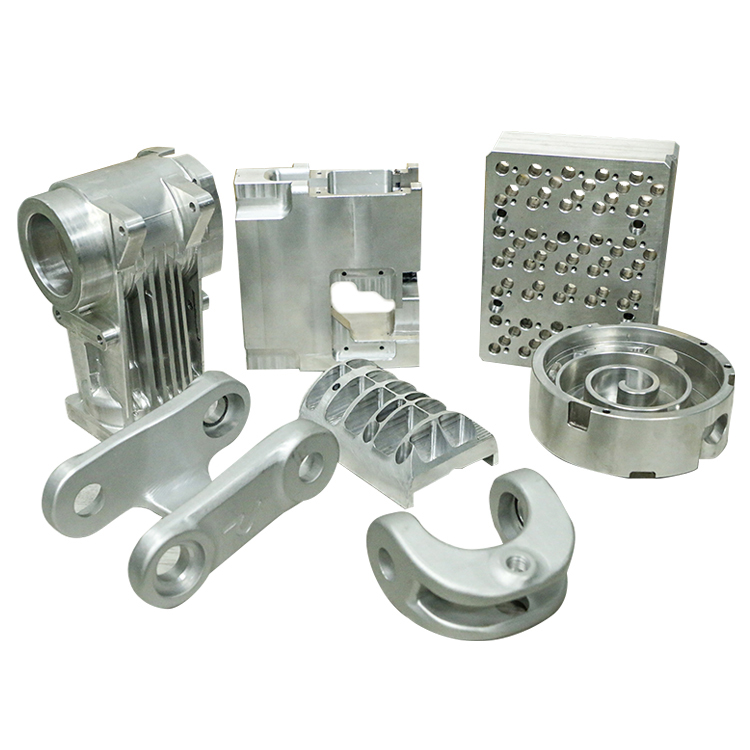
Steel
Steel is one of the most widely used materials in metal casting due to its strength, durability, and versatility. It is commonly used in industries that require high-performance components, such as automotive, construction, and machinery manufacturing. Steel castings can withstand high temperatures and heavy loads, making them ideal for producing structural parts like engine blocks, gears, and industrial equipment.
Steel alloys, such as carbon steel, alloy steel, and tool steel, offer different properties that make them suitable for various casting applications. The material's ability to be heat-treated enhances its strength, toughness, and resistance to wear, corrosion, and fatigue, making it a preferred choice for demanding environments.
Stainless Steel
Stainless steel is known for its excellent corrosion resistance, making it an ideal material for casting parts that must endure harsh environments. Its high resistance to rust and staining, combined with strength and durability, makes stainless steel an essential material in industries such as aerospace, medical devices, food processing, and chemical processing.
Stainless steel castings can be found in components like valves, pumps, fittings, and turbine parts. The material is also highly resistant to high temperatures and can maintain its strength and structural integrity under extreme conditions. Stainless steel is often used for precision casting methods like investment casting due to its ability to hold fine details.
Aluminum is one of the most commonly used metals in casting due to its lightweight, corrosion resistance, and excellent thermal and electrical conductivity. Aluminum castings are frequently used in industries such as automotive, aerospace, and electronics, where reducing weight while maintaining strength is essential.
Aluminum alloys can be tailored to specific needs, offering various levels of strength, hardness, and flexibility. Its high resistance to corrosion makes it ideal for outdoor applications, such as automotive parts (engine blocks, wheels) and aerospace components (wing structures, brackets). Aluminum casting methods, such as sand casting, die casting, and permanent mold casting, allow for the creation of complex shapes with fine details.
Copper
Copper is valued in casting for its excellent thermal and electrical conductivity, making it the material of choice for components such as electrical connectors, heat exchangers, and industrial machinery parts. Copper castings are known for their resistance to corrosion, particularly in marine environments, and can withstand high temperatures.
Copper alloys, such as bronze and brass, are often used in casting due to their improved strength, hardness, and wear resistance compared to pure copper. These alloys are frequently used in applications requiring high resistance to wear, such as gears, bearings, and valve components in industries such as power generation, plumbing, and mining.
Magnesium
Magnesium is a lightweight metal with exceptional strength-to-weight ratio, making it ideal for applications where reducing weight is crucial. It is commonly used in casting components for the automotive, aerospace, and electronics industries, where weight reduction can improve efficiency and performance.
Magnesium castings offer good machinability and high dimensional accuracy, making them suitable for producing intricate parts with complex shapes. Magnesium alloys, such as AZ91D, are often used for casting engine components, wheels, and housings in vehicles and aircraft. Despite its lightweight nature, magnesium provides good strength and can also be alloyed with other metals to enhance its properties further.
Zinc
Zinc is often chosen for its ease of casting, good corrosion resistance, and low cost. Zinc castings are widely used in the production of small, precision parts for industries such as electronics, automotive, and hardware. Zinc alloys, like ZA-8 and Zamak, are particularly popular for casting due to their low melting points and ability to produce complex shapes with high precision.
Zinc's low melting point allows for efficient casting processes, reducing energy costs and cycle times. It also provides good mechanical properties and surface finish, making it ideal for parts like electrical connectors, die-cast components, and decorative hardware.
Metal casting is used across a variety of industries to produce high-quality components and parts. The unique properties of cast metals allow manufacturers to create durable, complex, and cost-effective solutions for a wide range of applications. Below, we highlight some of the most common industries where metal casting plays a vital role in production.
The automotive industry relies heavily on metal casting to produce a wide array of components, including engine blocks, transmission housings, brake components, and wheels. Cast metals like aluminum and steel are preferred for their strength, durability, and lightweight properties, which are crucial for improving vehicle performance, fuel efficiency, and safety. In particular, aluminum castings are widely used for engine components due to their ability to reduce weight while maintaining strength.
Construction
In the construction industry, metal casting is used to produce structural components, such as steel beams, columns, and reinforced concrete forms. Cast metals like steel and iron provide the necessary strength and load-bearing capacity for buildings, bridges, and other infrastructure projects. Castings are also used for decorative architectural elements, such as window frames, doors, and railings, where both function and aesthetics are important.
Agricultural Machinery
Metal casting plays a critical role in the manufacturing of agricultural machinery and equipment. Cast parts such as tractor engines, plows, and gears are essential for the efficient operation of farming operations. The strength and durability of cast metals ensure that agricultural machinery can withstand the tough conditions it is subjected to in the field, providing long-lasting performance.
Mining
The mining industry also relies on metal casting for producing heavy-duty equipment that can endure the harsh and abrasive conditions of mining operations. Components such as crusher parts, conveyor rollers, and drilling equipment are often made from cast metals like steel and iron, which can withstand high wear and tear while offering the necessary strength and impact resistance.
Municipal Castings
Municipal castings refer to products that are used in public infrastructure projects, such as street drains, manhole covers, and signage. Cast iron is commonly used in municipal applications due to its ability to withstand the weight and wear of constant traffic, weather conditions, and corrosion. These cast parts are integral to maintaining urban infrastructure and ensuring public safety.
Pipes and Fittings
Metal casting is crucial in the production of pipes and fittings used in plumbing, oil and gas, and water distribution systems. Cast materials like steel, stainless steel, and ductile iron are used to produce durable and corrosion-resistant pipes that can handle high pressure and temperature conditions. The casting process allows for the creation of intricate pipe fittings that ensure leak-free connections and efficient fluid flow.
Railways
The railway industry uses metal casting for producing parts such as train wheels, axles, and couplings. These castings need to be durable and capable of withstanding the high stresses and vibrations experienced during operation. Cast iron and steel are often chosen for their strength and wear resistance, ensuring the safety and reliability of the rail system.
Metal casting is a fundamental process used across various industries, offering a versatile and cost-effective way to produce durable, high-performance components. Whether for automotive parts, construction materials, or machinery components, the materials used in metal casting and the industries that rely on it highlight the importance of this process in modern manufacturing.
The global metal casting industry has witnessed significant changes between 2023 and 2024, driven by fluctuations in demand, supply chain disruptions, and advances in casting technologies. By analyzing metal casting imports over the two years, we can identify key trends, challenges, and opportunities that have shaped the market.
2023 Trends
In 2023, the global metal casting market experienced a surge in demand across several sectors, including automotive, aerospace, and construction. The automotive industry, in particular, witnessed increased production of lightweight components, driving demand for aluminum and magnesium castings. The shift toward electric vehicles (EVs) further boosted demand for aluminum for lightweight battery housings and electric motor components.
However, the industry faced challenges such as rising raw material costs, supply chain disruptions due to geopolitical tensions, and labor shortages. These factors impacted the overall growth of the metal casting import market, causing some delays and price hikes for casting materials and components.
2024 Trends
In 2024, the global metal casting market is expected to recover from the setbacks experienced in 2023. Advances in automation and digital technologies, such as the use of AI and simulation software in casting processes, are expected to enhance efficiency and reduce defects, contributing to a more stable market. The increased adoption of sustainable casting practices, such as the use of recycled metals and eco-friendly sand molds, will also play a significant role in driving demand.
Additionally, the shift toward renewable energy, infrastructure development, and the resurgence of manufacturing in key regions like North America and Europe are likely to boost metal casting imports. These industries are anticipated to continue pushing the demand for high-performance cast components used in energy generation, construction, and transportation.
Key Takeaways
Metal casting is a critical manufacturing process that offers unmatched flexibility in producing complex shapes with high precision and strength. It allows manufacturers to create intricate parts with minimal material waste, making it a cost-effective solution for large-scale production. The versatility of metal casting makes it suitable for a wide range of applications, from automotive components to industrial machinery and artistic sculptures.
The process is especially valuable in industries that require durable and strong materials, such as aerospace, automotive, and heavy machinery. Furthermore, metal casting can be performed using a variety of metals, including steel, aluminum, bronze, and zinc, each offering unique properties to meet the specific needs of different applications.
Metal casting also supports the manufacturing of parts with complex geometries that would be difficult or impossible to achieve through other processes like machining or forging. Whether it’s for custom CNC machining parts or large-scale industrial applications, casting allows for precision, efficiency, and a variety of material options to choose from.
Metal casting plays an indispensable role in modern manufacturing due to its ability to produce large volumes of high-quality, precise parts. This process enables the creation of components with complex shapes that are often used in critical applications, such as engine blocks in vehicles, turbine blades in power plants, and frames for heavy machinery. The importance of metal casting extends beyond just the creation of products—it contributes to the advancement of industries and innovations across various sectors.
Metal casting continues to be a cornerstone of modern manufacturing, offering unmatched versatility, precision, and cost-effectiveness for a wide range of industries. Whether for producing critical components in automotive, aerospace, or industrial machinery, the process remains indispensable due to its ability to create strong, durable parts with intricate designs. As the global market recovers in 2024, innovations in technology, sustainability, and automation will continue to shape the future of metal casting, ensuring its relevance and importance for years to come.
For businesses involved in custom CNC machining or CNC machining services, metal casting provides a reliable and efficient method for producing complex parts and prototypes with minimal waste and maximum strength. As industries continue to demand higher performance and more sustainable solutions, the importance of metal casting will only continue to grow.
What does metal casting mean?
Metal casting is a manufacturing process in which a molten metal is poured into a mold to solidify and form a part or component with a specific shape. This process allows the production of parts with intricate designs, complex geometries, and high precision. Metal casting is used in various industries, including automotive, aerospace, and construction, to create durable and strong parts for machinery, equipment, and structures.
What is the process of metal casting?
The metal casting process involves several steps:
What are the four types of metal casting?
The four main types of metal casting are:
Can I cast metal at home?
Yes, casting metal at home is possible but requires specific equipment, materials, and safety precautions. Small-scale casting can be done using a furnace, molds, and protective gear. It's essential to have a well-ventilated space, wear personal protective equipment (PPE), and follow safety protocols to handle molten metals properly.
What is the easiest metal to cast at home?
The easiest metals to cast at home are generally those with a low melting point, such as:
These metals are easier to handle compared to higher melting point metals like steel or copper.
Why can't I cast steel?
Casting steel can be challenging at home due to its high melting point (around 1370°C/2500°F), which requires specialized equipment like high-temperature furnaces. Additionally, steel is more prone to defects during cooling, which makes it difficult to achieve a high-quality cast without controlled conditions.
Can magnets hold cast steel?
Yes, magnets can hold cast steel, as steel is a ferromagnetic material. However, the magnetic strength can vary based on the specific type of steel and its composition. Some alloyed steels may have reduced magnetic properties, but in general, cast steel will be attracted to magnets.
Can you weld cast steel with a MIG welder?
Yes, you can weld cast steel with a MIG (Metal Inert Gas) welder, but it requires proper preparation. Cast steel can be more brittle compared to wrought steel, so preheating the material and using the right filler material is important to avoid cracking. Proper technique and welding procedures are crucial when welding cast steel.
How to cast metal safely?
To cast metal safely, follow these steps:
Which metal is easiest to cast?
The easiest metals to cast are those with low melting points, such as:
However, always prioritize safety when casting metals, especially those with toxic fumes or higher melting points.
At what temperature do you cast metal?
The temperature at which you cast metal depends on the specific type of metal being used. Here are the melting points for common casting metals:
Ensure you heat the metal to the appropriate temperature for casting, as this will affect the flow, mold filling, and final quality of the cast part.
